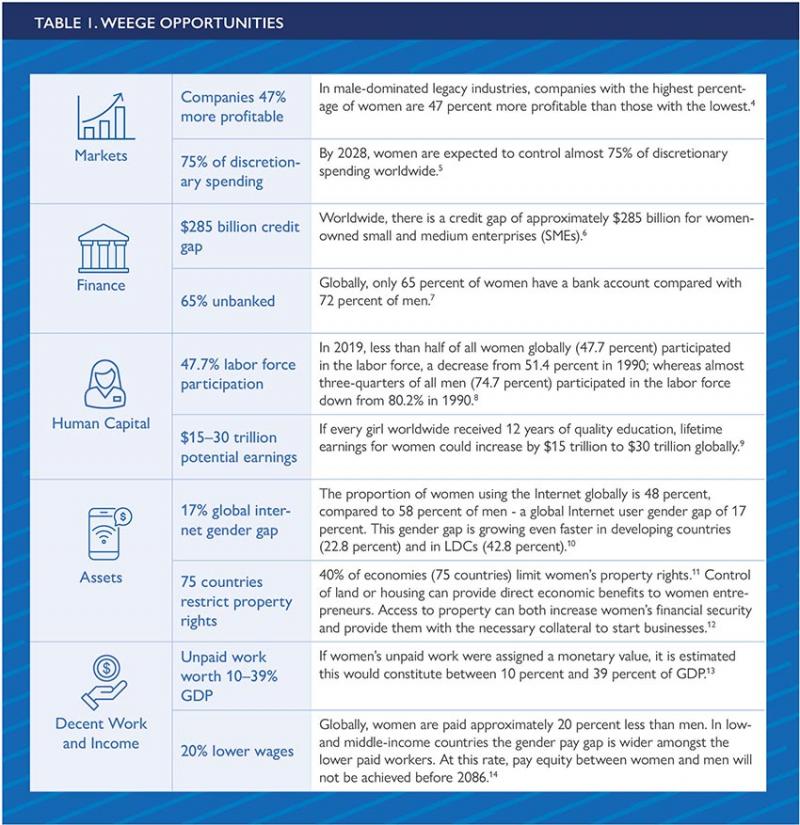1.2. WEEGE Barriers, Opportunities and Evidence
To help countries to achieve self-reliance (as described in Box 2), as well as to meet the 2030 Sustainable Development Goals, women’s economic empowerment and gender equality must become cornerstones of development programming. There are some promising developments. The past decades have seen a significant increase in the health and education levels of women and girls. Similar progress, however, has yet to be achieved in women’s economic empowerment. Women continue to trail men in formal labor force participation, rates of entrepreneurship, and income levels, in part because of structural barriers (including inadequate access to credit and weak inheritance and ownership rights) and in part due to social norms and unconscious bias in the workplace.
Box 2: WEEGE Alignment with USAID's vision and U.S. National Security Strategy
|
When women do join the labor force, they are more likely to work part-time and in occupations that pay less. Moreover, 58 percent of women globally rely on income from work in the informal sector (such as domestic work or self-employed, home-based work) which is more vulnerable.Global Commission on the Future of Work, “Empowering women working in the informal economy” (International Labour Organization, February 2018). Available at https://www.ilo.org/wcmsp5/groups/public/---dgreports/---cabinet/documents/publication/wcms_618166.pdf As a result, women earn less than men on average, which, in turn, diminishes their bargaining power and voices in both workplaces and households.
The gender wage gap also has significant global economic implications. The World Bank estimates countries are losing $160 trillion in wealth because of differences in lifetime earnings between women and men.Quentin Wodon and Benedicte de la Briere, “The Cost of Gender Inequality – Unrealized Potential: The High Cost of Gender Inequality in Earnings” (The World Bank Group, May 2018). Available at https://openknowledge.worldbank.org/bitstream/handle/10986/29865/126579-Public-on-5-30-18-WorldBank-GenderInequality- Brief-v13.pdf?sequence=1&isAllowed=y Reducing gender gaps can have far-reaching benefits: it boosts economic growth and productivity; leads to greater equality in the overall income distribution; supports higher corporate profits; increases economic resilience; supports bank stability; contributes to improving other development outcomes.“Pursuing Women’s Economic Empowerment” (International Monetary Fund (IMF), 2018). Available at https://www.imf.org/en/Publications/Policy-Papers/Issues/2018/05/31/pp053118pursuing-womens-economic-empowerment#:~:text=The%20economic%20and%20social%20imperative%20for%20women%E2%80%99s%20economic,economic%20diversification%20and%2C%20in%20turn%2C%20supports%20economic%20resilience A significant body of academic, donor-funded and evaluative research and evidence supports this conclusion. Table 1 highlights some of the opportunities offered through meaningfully advancing WEEGE, alongside the risks of continuing under a business-as-usual scenario.
Image

Footnotes from table: “Legacy industries” refers to fourteen well-established industries across a range of sectors, including energy, materials, industrials, consumer products, utilities, and waste services. Source: ”Women as Levers of Change: Unleashing the Power of Women to Transform Male-Dominated Industries,” FP Analytics, 2020. Available at: https://womenasleversofchange.com/ “Is the X chromosome the X factor for business leadership? Find out why companies led by women are outpacing the market,” EY, 2018. Available at: https://www.ey.com/en_us/growth/growth-barometer-diversity “Investing in Women: New Evidence for the Business Case,” International Finance Corporation (IFC), 2017. Available at: https://www.ifc.org/wps/wcm/connect/ac8fca18-6586-48cc-bfba-832b41d6af68/IFC+Invest+in+Women+October+2017.pdf?MOD=AJPERES&CVID=lYLVAcA "Demirgüç-Kunt, Asli; Klapper, Leora; Singer, Dorothe; Ansar, Saniya, and Hess, Jake. “The Global Findex Database 2017: Measuring Financial Inclusion and the Fintech Revolution,” The World Bank Group, 2018. Available at: https://globalfindex.worldbank.org/ “Women in the Workforce - Global: Quick Take” Catalyst, Available at: https://www.catalyst.org/knowledge/women-workforce-global Wodon, Quentin; Montenegro, Claudio; Nguyen, Hoa; and Onagoruwa, Adenike; “Missed Opportunities: The High Cost of Not Educating Girls,” July 2018, Available at: https://www.globalpartnership.org/content/missed-opportunities-high-cost-not- educating-girls “Measuring Digital Development, Facts and Figures 2019,” International Telecommunication Union (ITU), 2019. Available at: https://www.itu.int/en/ITU-D/Statistics/Documents/facts/FactsFigures2019.pdf Women Business and the Law 2020, World Bank, 2020. Available at: https://openknowledge.worldbank.org/bitstream/handle/10986/32639/9781464815324.pdf?sequence=10#:~:text=Women%2C%20Business%20and%20the%20Law%202020%20finds%20that,regions%20and%20income%20groups%20have%20made%20women%E2%80%99s%20eco- Women’s Workplace Equality Index, Available at: https://www.cfr.org/legal-barriers/country-rankings/ UNRISD, Research and Policy Brief 9: Why Care Matters for Social Development. Available at: https://www.files.ethz.ch/isn/113201/RPB9e.pdf Global Wage Report 2018/19: What lies behind gender pay gaps, ILO, November 2018. Available at: https://www.ilo.org/global/publications/books/WCMS_650553/lang--en/index.htm
For additional facts and figures about WEEGE, refer to Resource 1: Data Sources which provides a list of relevant sources for gender-related data.

